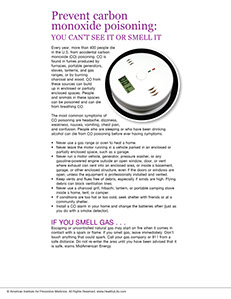SYMPTOM CHECKER
CONDITIONS
Male
Female
Child
Arm, Hand & Shoulder Concerns
Legs & Feet Concerns
Dental & Mouth Concerns
Ear & Nose
Eye Conditions
Head Conditions
Arm, Hand & Shoulder Concerns
Legs & Feet Concerns
Front
Back
Arm, Hand & Shoulder Concerns
Dental & Mouth Concerns
Ear & Nose
Eye Conditions
Head Conditions
Arm, Hand & Shoulder Concerns
Dental & Mouth Concerns
Ear & Nose
Eye Conditions
Head Conditions
Front
Back
Arm, Hand & Shoulder Concerns
Neck Links
Head & Neck Concerns
Arm, Hand & Shoulder Concerns
Neck Links
Head & Neck Concerns
Front
Back
Online Clinic
Wise Healthcare
Prevent carbon monoxide poisoning: You can’t see it or smell it

Every year, more than 400 people die in the U.S. from accidental carbon monoxide (CO) poisoning. CO is found in fumes produced by furnaces, portable generators, stoves, lanterns, and gas ranges, or by burning charcoal and wood. CO from these sources can build up in enclosed or partially enclosed spaces. People and animals in these spaces can be poisoned and can die from breathing CO.
The most common symptoms of CO poisoning are headache, dizziness, weakness, nausea, vomiting, chest pain, and confusion. People who are sleeping or who have been drinking alcohol can die from CO poisoning before ever having symptoms.
• Never use a gas range or oven to heat a home.
• Never leave the motor running in a vehicle parked in an enclosed or partially enclosed space, such as a garage.
• Never run a motor vehicle, generator, pressure washer, or any gasoline-powered engine outside an open window, door, or vent where exhaust can vent into an enclosed area, or inside a basement, garage, or other enclosed structure, even if the doors or windows are open, unless the equipment is professionally installed and vented.
• Keep vents and flues free of debris, especially if winds are high. Flying debris can block ventilation lines.
• Never use a charcoal grill, hibachi, lantern, or portable camping stove inside a home, tent, or camper.
• If conditions are too hot or too cold, seek shelter with friends or at a community shelter.
• Install a CO alarm in your home and change the batteries often (just as you do with a smoke detector).
If you smell gas . . .
Escaping or uncontrolled natural gas may start on fire when it comes in contact with a spark or flame. If you smell gas, leave immediately. Don’t touch anything that could spark. Call your gas company or 911 from a safe distance. Do not re-enter the area until you have been advised that it is safe, warns MidAmerican Energy.
This website is not meant to substitute for expert medical advice or treatment. Follow your doctor’s or health care provider’s advice if it differs from what is given in this guide.
The American Institute for Preventive Medicine (AIPM) is not responsible for the availability or content of external sites, nor does AIPM endorse them. Also, it is the responsibility of the user to examine the copyright and licensing restrictions of external pages and to secure all necessary permission.
The content on this website is proprietary. You may not modify, copy, reproduce, republish, upload, post, transmit, or distribute, in any manner, the material on the website without the written permission of AIPM.
2021 © American Institute for Preventive Medicine - All Rights Reserved. Disclaimer | www.HealthyLife.com















































